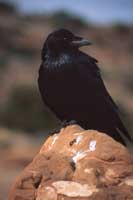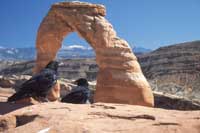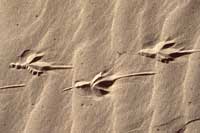January is a special month in Canyon Country. Winter snows and arctic air descend on the landscape cloaking the area in an aura of silence interrupted by groaning ice and the occasional rock fall. Wildflowers lay entombed beneath a layer of snow or suspended growth due to the cold. The area seems suspended in time, patiently awaiting the arrival of spring and warmer weather.
 Yet throughout the cold, life continues. Deer still roam the canyons and cottontails forage across the frozen ground. Red-tailed and rough-legged hawks brood on power poles and fence posts waiting for some careless rodent movement. But during this time it is the ravens that I notice the most, as the birds swim through the air with their rowing-like wing strokes.
Yet throughout the cold, life continues. Deer still roam the canyons and cottontails forage across the frozen ground. Red-tailed and rough-legged hawks brood on power poles and fence posts waiting for some careless rodent movement. But during this time it is the ravens that I notice the most, as the birds swim through the air with their rowing-like wing strokes.
Perhaps it is their dark coloration, black feathers contrasting against the white backdrop, which leads me to these corvids. Maybe it is their harsh “quocks” that shattered the stillness and echo across the landscape. Or it could be their communal nature, their sharing of winterkill resources that draws in relatives and strangers to a feast. Sometimes found in company of the crows or coyotes, the large ravens fill a similar role as their desert dwelling cousins: scavengers.
Rarely do I see a solitary raven picking clean the sufferings of winter. Relying on scraps leftover from predators or the unexpected bonanza of locating a carcass, the ravens glean life from death. Like other corvids, ravens can cache food for later consumption. But unlike their distant relatives the jays and nutcrackers whose recollection for stored food is uncanny, ravens don’t have that strong of a memory. Maybe it is how they get their meals versus what they eat that they find interesting.
Our raven here is the common raven (Corvus corax) one of two species found in the Southwest. The smaller Chihuahuan raven occurs farther south in the Chihuahuan Desert area of northern Mexico and southern Arizona. The common raven occurs across the western U.S., Alaska, Canada and into the northeast. 
In winter ravens tend towards flocks or at least small groups of birds that play on updrafts and seem to be enjoying themselves. I know that is anthropomorphic, but they do. And no matter if I am out in the Matheson Preserve, the Cisco Desert or strolling mesa top trails, I find great delight in watching the antics and aerial acrobatics of a flock of ravens as they pursue their next meal or just seem to be goofing off.
 And why not for a bird that many ornithologists and bird researchers label as one of the most intelligent members of the avian community. Not that they can figure out quadratic equations (who can!), but these birds exhibit a strong ability to problem solve. Like juvenile ravens that make a unique call, a yell that sounds the dinner bell inviting other birds to join in, even if those other birds are not relatives. Or the raven that uses a stick to probe into an ant hill for food. Or how raven calls may also attract other predators to prey, ones with fangs and jaws tough enough to break bones and shred carcasses, exposing the meat that the ravens are after. They are like the Huck Finns of the bird world, getting others to do their work.
And why not for a bird that many ornithologists and bird researchers label as one of the most intelligent members of the avian community. Not that they can figure out quadratic equations (who can!), but these birds exhibit a strong ability to problem solve. Like juvenile ravens that make a unique call, a yell that sounds the dinner bell inviting other birds to join in, even if those other birds are not relatives. Or the raven that uses a stick to probe into an ant hill for food. Or how raven calls may also attract other predators to prey, ones with fangs and jaws tough enough to break bones and shred carcasses, exposing the meat that the ravens are after. They are like the Huck Finns of the bird world, getting others to do their work.
Winter doesn’t last long in Canyon Country, but it does offer some unique opportunities for watching the native fauna, especially the ravens, carrying out their business.

 Yet throughout the cold, life continues. Deer still roam the canyons and cottontails forage across the frozen ground. Red-tailed and rough-legged hawks brood on power poles and fence posts waiting for some careless rodent movement. But during this time it is the ravens that I notice the most, as the birds swim through the air with their rowing-like wing strokes.
Yet throughout the cold, life continues. Deer still roam the canyons and cottontails forage across the frozen ground. Red-tailed and rough-legged hawks brood on power poles and fence posts waiting for some careless rodent movement. But during this time it is the ravens that I notice the most, as the birds swim through the air with their rowing-like wing strokes. 
 And why not for a bird that many ornithologists and bird researchers label as one of the most intelligent members of the avian community. Not that they can figure out quadratic equations (who can!), but these birds exhibit a strong ability to problem solve. Like juvenile ravens that make a unique call, a yell that sounds the dinner bell inviting other birds to join in, even if those other birds are not relatives. Or the raven that uses a stick to probe into an ant hill for food. Or how raven calls may also attract other predators to prey, ones with fangs and jaws tough enough to break bones and shred carcasses, exposing the meat that the ravens are after. They are like the Huck Finns of the bird world, getting others to do their work.
And why not for a bird that many ornithologists and bird researchers label as one of the most intelligent members of the avian community. Not that they can figure out quadratic equations (who can!), but these birds exhibit a strong ability to problem solve. Like juvenile ravens that make a unique call, a yell that sounds the dinner bell inviting other birds to join in, even if those other birds are not relatives. Or the raven that uses a stick to probe into an ant hill for food. Or how raven calls may also attract other predators to prey, ones with fangs and jaws tough enough to break bones and shred carcasses, exposing the meat that the ravens are after. They are like the Huck Finns of the bird world, getting others to do their work.